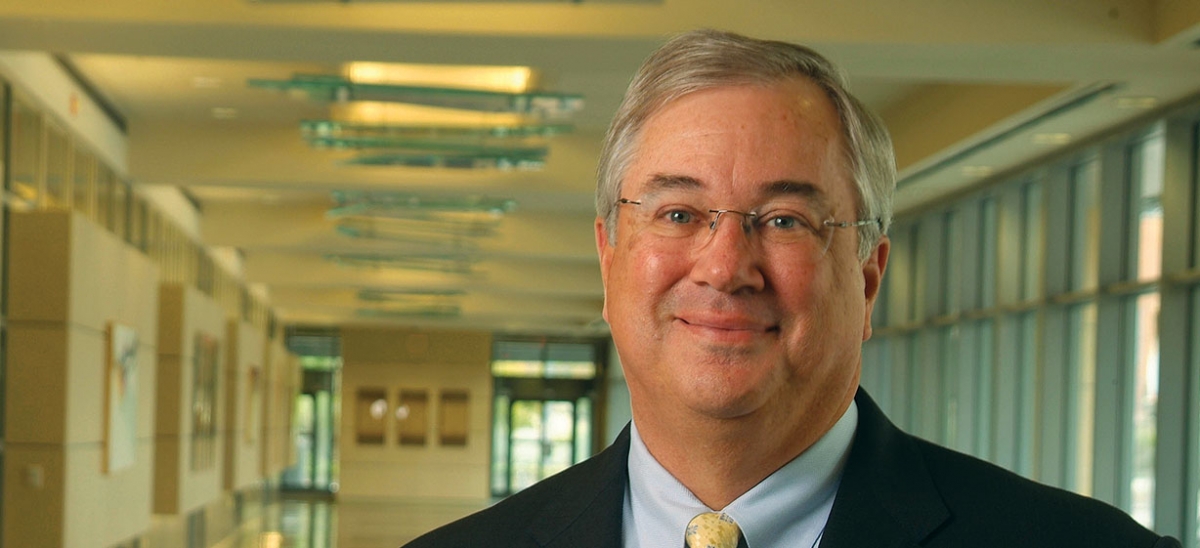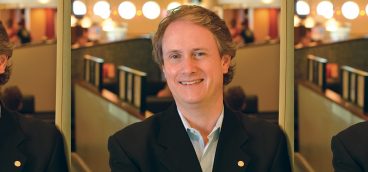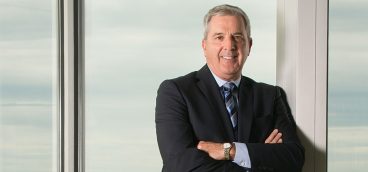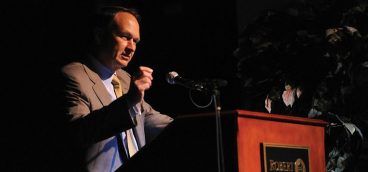A Pittsburgh banking career

In April, Jim Rohr will retire as Executive Chairman of PNC Financial Services Inc. His 42-year career with the bank includes 13 years as CEO, a span that has seen PNC become one of the nation’s largest banks. Rohr has also been one of Pittsburgh’s greatest modern corporate leaders in civic affairs, championing a wide array of regional initiatives at the time when Pittsburgh turned the corner after decades of malaise. On the eve of his retirement, Rohr fielded six questions from Pittsburgh Quarterly.
What was Pittsburgh like when you arrived and what changes have you seen?
I interviewed with the bank in 1971. I had graduated from Notre Dame, and Ohio State gave me a deal: They’d pay me $300 a month for teaching statistics and I’d get free tuition. But I needed a job; I had a wife and a child on the way and no money. I came through the tunnel for the interview not knowing what to expect, and it was very different from what I expected. I had some other offers, but I liked the people here. I started in May of ’72 as a trainee at Pittsburgh National Bank, a tiny little bank of a billion and a half dollars. I was 24.
There were mills up and down both sides of the river, and Homestead was the biggest mill in the world. Pittsburgh was the third-largest corporate center in the world. Through the ’70s, the steel industry was very busy and very successful. In the late ’70s, the steel bubble really burst, and Pittsburgh started to close mills in the ’80s. Thirty years ago was the bottom for Pittsburgh. There was almost 20 percent unemployment, and 50,000 people left town. It was a gloomy place in ’83, ’84 and ’85 as the continued layoffs in steel hurt us.
Now we’ll have had 30 cities come and visit us in an 18- to 20-month period, asking us how we recovered. They all want the plan of what some genius wrote up in 1984 and they want to just follow it. But of course there was no plan. And then they look for the messiah. We didn’t have any. They ask us how we did it, and we’re not very good at explaining it. What I’ve now come around to is that it’s the culture of Pittsburgh that has allowed us to thrive. People will say we have Carnegie Mellon University, the University of Pittsburgh and UPMC. And we have PNC, Mellon, PPG and U.S. Steel. And we have the foundations. And I would say, yes, we have all those things, but no one of them took us from where we were in 1984 to today, and we lost a lot along the way.
What made the difference is how the people have worked together to make things happen. Jack Heinz said that the Cultural District was a Cultural District. Actually it was a red light district. People laughed. But they convened the individuals, companies and foundations. Everybody came together. And over a long period of time, there’s a lot of money that went into the Cultural District that doesn’t have anybody’s name on it. But it’s all for the betterment of the city. I would argue that if we hadn’t redone the Cultural District, that the Convention Center would never have been built there. Alcoa would not have built across the river if it was still a red light district, and the stadiums might have gone somewhere else if downtown was unattractive.
Mellon took over the Dravo building and expanded their operation center up there. The History and Landmarks Foundation and Dick Scaife created Station Square. A number of people got together to do Schenley Plaza. Go around town. The Parks Conservancy—a group raised the money and made that work. The Phipps and The Hillman Cancer Center—there are a lot of people who have worked together to make that happen.
At the same time, Google comes to town to work with CMU; now they’re running out of space there. Google doesn’t go places where the quality of life isn’t any good. And the quality of life here? We’ve been named the Most Livable City the last several years—it is the most livable city. Google said they came here for the same reason the steel guys came at the turn of the century—raw material. Now that raw material is the students at CMU and Pitt. And I think we’re only beginning to see what the Marcellus [Shale] might do for us. The Financial Times called us the single best city in North America to begin a career. In many ways, we’re where we were at the turn of the last century—except that with technology, healthcare, finance and energy, we’re more diverse.
What does the region’s future look like to you?
I think it’s terrific. I think the Financial Times is right. The nice thing about Pittsburghers is that we never sit around talking about how good things are—we talk about how to make things better. The Heinz Endowments is working to making the air quality better. We are constantly working (maybe through our complaints) on things that aren’t as good as they might be. This thing between UPMC and Highmark—I hope that can be resolved. We have an airport that’s underutilized. But unemployment is low, and jobs are growing. We have unbelievable arts, sports teams, parks, educational systems, healthcare and finance. If you sat down in the middle of the night and made a list of what you’d want—this is what you’d say. The future here is as bright today as it has ever been.
What obstacles do we face and what problems do we need to solve?
One of the issues for corporations is transportation. More flights to more destinations from our airport would be very helpful. Maybe 10 or 15 yeas from now it won’t matter; everyone will do business on Skype. But for now, it’s an issue. It’s important for us to have at least one direct flight to Europe.
Having access to the doctor you want through the insurance company you want is an issue.
But there are more opportunities than problems. Downtown is totally changed. I remember before we built Three PNC, I would see people come back from PNC Park, cross the bridge, get to Liberty Avenue and turn back. Those blocks were unlit—not dangerous, but dark. Now those areas have been redone and people are moving downtown. We’ve been changing pieces of the puzzle. Now you’ve got to make reservations. It’s fun. Point Park has been working hard to redo the Wood Street corridor, which is the last piece that has to be redone. And our new tower will be built there. They’ll move the Playhouse downtown from an overcongested Oakland, and that’ll make downtown even more vibrant.
When I think about what’s happened, it’s one of the most remarkable things. The people of Pittsburgh, by working together, have recreated this city in a way that nobody could have planned and no one person could have done.
What do you perceive PNC’s trajectory to be, both as a corporation and in regard to its effect on Pittsburgh?
PNC is in great shape. We’ve grown dramatically. We’re now the fifth or sixth largest bank in the country, depending on what you measure. The opportunities are dramatic. We’re a leader in technology and we’re very well capitalized and very liquid. We want to make loans. Most important, we have fabulous employees, and that’s what the banking business is all about. PNC is well positioned for a lot of success for a long time to come. We have a great management team. This is our home. I would fully expect that the corporate leadership in town would remain the same and actually get bigger.
Discuss one or two pivotal moments of your career and how you handled them.
Being hired here was a big deal. I have trainees who asked me how did I figure out this small bank would survive all these years and I’d be the chairman and CEO. Of course, there’s no way I could have known. I was lucky there, very fortunate. My brother gave me some advice one time. I was upset and thinking about leaving. He was 10 years older, and he asked me if I had another job. I said, “No.” And he said, “No matter how bad things are, they’re worse if you don’t have any money.” And that was pretty good advice.
When Tom O’Brien retired, his naming me the chief was a big deal. The month he retired was the peak of the Dow and the Nasdaq—and then it was downhill. We had to change the company a lot. We spent a lot of time building teamwork and working on risk. I was very fortunate having a group of people around me who took customer service very seriously, which is the hallmark of this company. And we care deeply about our employees. When you put those together, the shareholder wins. And then along came the financial crisis and we were well positioned to grow even further during that time. That’s changed the nature of the future for PNC. It’s allowed us to spend money on products and services for our customers.
Finally, what would you say are the key ingredients of success?
Success can be defined so many ways. It’s very difficult to answer that question. If you’re a swimmer, it’s good to be able to hold your breath. I can’t do that and I don’t run very fast either. And if I look backward, I was not the best student.
Success really is driven by a combination of things. You have to have enough talent to play, and you’ve got to be committed. And being committed means you’re willing to put in the hours and the work. And in my case, you had to be a team player—because the team always beats the individual. And you have to be lucky. I guess I was bright enough. I certainly was very fortunate. But I liked working with people, and it was easy for me to realize I couldn’t do it myself.
And I worked really hard. To be a teammate, you’ve got to work hard—and respect the people you’re with and give them credit. If you think it’s all about you, it’s not. It’s a combination of people, and I’ve been very fortunate to work with hundreds and thousands of people. That’s what the success of Pittsburgh is about—people working together to make things work.





